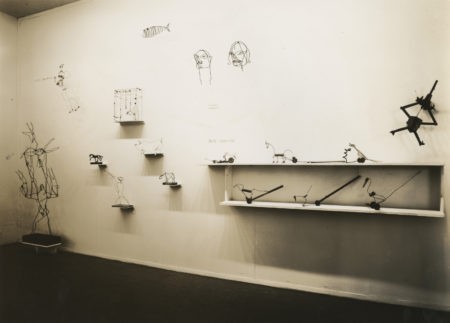


The Museum of Modern Art, New York. Alexander Calder: Sculptures and Constructions. 29 September 1943–16 January 1944.
Solo ExhibitionSolomon R. Guggenheim Museum, New York. Alexander Calder: A Retrospective Exhibition. 6 November 1964–31 January 1965.
Solo ExhibitionMusée National d’Art Moderne, Paris. Calder. 8 July–15 October 1965. Originated from the Solomon R. Guggenheim Museum, New York.
Solo ExhibitionWhitney Museum of American Art, New York. Calder’s Universe. 14 October 1976–6 February 1977.
Solo ExhibitionPalazzo a Vela, Turin, Italy. Calder: Mostra retrospettiva. 2 July–25 September 1983.
Solo ExhibitionNational Gallery of Art, Washington, D.C. Alexander Calder: 1898–1976. 29 March–12 July 1998.
Solo ExhibitionMusée National d’Art Moderne, Centre Georges Pompidou, Paris. Alexander Calder: les années parisiennes 1926–1933. 18 March–20 July 2009. Originated from the Whitney Museum of American Art, New York.
Solo ExhibitionTate Modern, London. Alexander Calder: Performing Sculpture. 11 November 2015–3 April 2016.
Solo ExhibitionWhitney Museum of American Art, New York. Calder: Hypermobility. 9 June–23 October 2017.
Solo ExhibitionFundación Proa, Buenos Aires. Alexander Calder: Theater of Encounters. 8 September 2018–15 January 2019.
Solo ExhibitionPace Gallery, New York. Calder: Small Sphere and Heavy Sphere. 14 September–26 October 2019.
Solo ExhibitionDi Donna Galleries, New York. Enchanted Reverie: Klee and Calder. 19 April–8 June 2024.
Group ExhibitionCalder creates his first formal mechanized sculpture, Goldfish Bowl, and presents it to his mother as a Christmas gift. For his father, he makes a brass wire fish. In a letter to Peggy, Nanette writes, He made me a fish tank of brass wire, with two fish that wiggle as you turn a crank made
also of wire. Waves are indicated along the top. For your Dad a large fish that is now hanging from the electric light. Peggy, it is remarkable. One wire beginning at his tail, running along the backbone to the head where the eyes and mouth are faultlessly placed. Then the wire loops around the back bone as it travels back to form the other half of the tail. This is hard to describe, but it is really wonderful as is the fish bowl in which the fishes bend as tho [sic] swimming.
Soon after moving to Paris in 1926, Calder created his Cirque Calder. Made of wire and a spectrum of found materials, the Cirque was a work of performance art that gained Calder an introduction to the Parisian avant-garde. He continued to explore his invention of wire sculpture, whereby he “drew” with wire in three dimensions the portraits of friends, animals, circus themes, and personalities of the day.